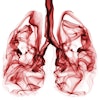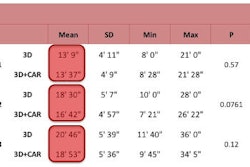Extracolonic abnormalities occur more frequently among older and symptomatic patients, and are more cost-effective to detect in these populations, according to researchers from Korea. Their multicenter study examined a large screening cohort with virtual colonoscopy using a variety of exam techniques.
The ability of virtual colonoscopy (also known as CT colonography or CTC) to find suspicious lesions outside the colon gives it an edge over optical colonoscopy, which is limited to examining the colonic lumen. But the prevalence of extracolonic abnormalities in older patients, and the costs associated with detecting and treating them, remain poorly understood.
Study authors Dr. Sung Keun Park, Dr. Dong Il Park and colleagues explored these issues in a study published in the World Journal of Gastroenterology (March 28, 2009, Vol. 15:12, pp. 1487-1492). Both Parks are from Sungkyunkwan University School of Medicine in Seoul.
Despite impressive gains brought about by improvements in CT technology, virtual colonoscopy, with its commonly detected extracolonic findings, "has been described as a sort of Pandora's box, releasing a cascade of diagnostic events with medicolegal, ethical, and economic implications," they wrote. "Therefore, it would be helpful to clinicians if there were defined strategies for the clinical approach toward the detection of highly significant extracolonic lesions."
The study aimed to assess the frequency and significance of extracolonic abnormalities in a large Korean cohort, as well as analyze the cost-effectiveness of treating them to develop strategies to enhance the potential benefits of VC exams.
The researchers evaluated data from 920 CTC cases (535 men, 385 women; mean age, 57.3 ± 12.8 years) from seven university hospitals in Korea. Patients who were diagnosed as having a malignancy at the time of VC were excluded from the study.
Following cathartic bowel preparation, room air insufflation of the colon, and the acquisition of a scout image, the subjects were scanned prone and supine on one of six scanner models (eight to 64 detector rows), at 120 kVp and mAs ranging from 30 to 200. Collimation and reconstruction intervals ranged from 1.25 mm to 5 mm. Iodinated contrast was administered in most of the subjects (764/920, 83%) before scanning.
Based on previous papers, the researchers divided extracolonic findings into three categories, including highly significant lesions requiring immediate intervention or follow-up investigation (i.e., solid organ masses, abdominal aortic aneurysm > 3 mm), lesions of indeterminate significance (i.e., intermediate cysts, calculi), and those of low significance (i.e., diverticulosis, hernias). Differences between the groups were analyzed using chi-square and student's t-tests.
"Medical records were reviewed to establish whether further investigation was carried out pertaining to the extracolonic lesions that were detected by CT colonography during the one-year follow-up period," Park and colleagues wrote. Cost-effectiveness was based on the cost of detecting a single highly significant lesion.
In all, 692 extracolonic findings were detected in 532 (57.8%) patients, of which 60 lesions (8.7%) were highly significant, 250 (36.1%) were of intermediate significance, and 382 (55.2%) were of low significance, the group reported.
Of the 60 significant findings, 42 were solid organ masses suspicious for malignancy. Other significant findings included cardiomegaly/pericardial effusion (n = 5), lymphadenopathy > 1 cm (n = 3), peritoneal carcinomatosis (n = 3), abscess (n = 3), aortic lesion (n = 2), and small bowel obstruction (n = 2).
Virtual colonoscopy found fewer extracolonic lesions in asymptomatic and younger subjects (p < 0.001), as well as in those whose exams were performed without contrast enhancement. Findings of high significance occurred in only 27% of asymptomatic screening subjects.
"Regression analysis revealed that older age (p < 0.001), being female (p = 0.001), the presence of symptoms (p < 0.001), and the use of contrast (p = 0.003) were associated with the detection of significant extracolonic lesions," they wrote.
Based on the total cost of the CTC exams, the authors found that each of the 60 highly significant extracolonic lesions cost $2,905 to detect in patients older than 60. Poorer cost-effectiveness was observed in subjects less than 60 years of age ($3,442), asymptomatic subjects ($3,737), and those in whom CTC was performed without the use of contrast ($4,221).
"The cost of a CT colonography in Korea, i.e., $190 ... is only $53 ... more expensive than colonoscopy," they wrote. "Therefore, [CTC] might be more attractive in Korea, since it is less expensive when compared with the U.S."
Extracolonic lesions were found in 459 of 764 subjects (60%) examined with contrast enhancement versus 73 of 156 (46.8%) who were scanned without the use of contrast enhancement (p = 0.005).
"Apart from age and clinical symptoms, contrast enhancement was found to be advantageous in identifying extracolonic lesions on CT colonography," the authors wrote. "This demonstrates that some important lesions might have been overlooked in noncontrast-enhanced cases."
The inability of low-radiation-dose CT colonography to accurately define lesions in other organs also raises important medicolegal considerations, the group noted. "Based on our findings, age and the presence of gastrointestinal symptoms and the use of contrast enhancement must be taken into account when deciding when to use CT colonography in routine clinical practice."
Further treatment was performed in 81.7% of those with lesions of high significance, versus 20.8% and 2.9% of subjects with lesions of intermediate and low significance, respectively.
Limitations
The methodology of the study may limit the extent to which the group's findings be extrapolated. The group calculated their analysis of the cost-effectiveness of VC based on the cost of finding each significant extracolonic abnormality, calculated as the total cost of all screening studies divided by the number of significant abnormalities in the cohort.
The principal limitation of such a method is that it accords no value to the benefit of colorectal cancer screening itself. Nor were the costs of following up and treating detected extracolonic lesions calculated, a task that could presumably be performed in a further analysis of the data.
In addition to the rudimentary cost-analysis method noted previously, the authors listed the principal limitation of the study as the inhomogeneity of exam settings, including mAs and slice thickness. Still, slice thickness and dose were not predictors of the presence of extracolonic lesions, they added.
"Most of the extracolonic lesions ... were of low significance, and resulted in additional costly investigations," they concluded. "However, CT colonography may demonstrate asymptomatic malignant disease requiring immediate treatment in older subjects, and among those with symptoms, particularly when performed with contrast enhancement."
Based on the results, contrast-enhanced CTC should be used in older adults, Park and colleagues wrote.
By Eric Barnes
AuntMinnie.com staff writer
April 22, 2009
Related Reading
CT colonography may yet challenge colonoscopy, April 16, 2009
VC/AAA screening combo cost-effective in older adults, March 26, 2009
Adding CAD to virtual colonoscopy saves lives and money, February 24, 2009
VC's extracolonic findings lend an edge in cost-effectiveness, April 15, 2008
Extracolonic findings double VC costs, but might be worth paying, July 20, 2006
Copyright © 2009 AuntMinnie.com



















